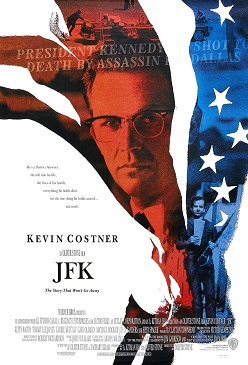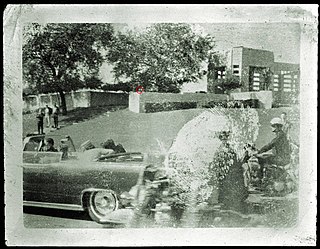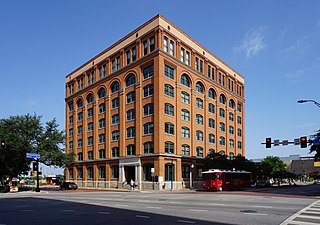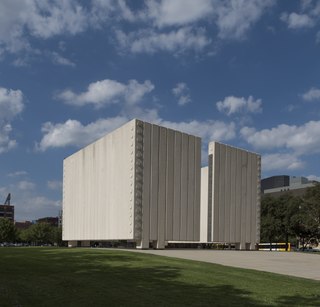This article needs additional citations for verification .(July 2021) |
James F. Chambers Jr (1913-2006) was a long-time newspaperman who became the Chairman of the Board and Publisher of the Dallas Times Herald .
This article needs additional citations for verification .(July 2021) |
James F. Chambers Jr (1913-2006) was a long-time newspaperman who became the Chairman of the Board and Publisher of the Dallas Times Herald .
Chambers was born May 13, 1913, to James F. and Elizabeth Troutman Chambers. While born in Houston, he was raised in Dallas. After attending public schools, he transferred to the Terrill School for Boys, where he graduated in 1931. As he later recounted, “I went there to prepare for entrance into Boston Tech (the forerunner to MIT). My father wanted me to be an engineer like he was.” [1]
Chambers’ career path changed dramatically during the summer after his high school graduation. He took a job writing obituaries and short pieces for the daily Dallas Dispatch and decided to accept a full-time job with the newspaper. Instead of going to MIT, he worked full time while taking classes, eventually graduating from Southern Methodist University.
At the time, the Dispatch was one of the four daily newspapers in Dallas. In addition to reporting, Chambers became City Editor at the Dispatch, where he worked for 7 years. In doing so, he often competed for stories with more veteran newspapermen. As he later recounted, “these were the last of the old boys who never let the facts get in the way of a good story.” [1]
In 1934, the 21-year-old Chambers wrote a graphic account of the killing of Bonnie and Clyde. Not only was Chambers supposedly present at the ambush, he “rode back to Dallas with Barrow’s body in a hearse.” [1]
A year later, in 1935, the city’s newspapers were intensely covering the trial of the man who had allegedly kidnapped and killed Charles Lindbergh’s baby. When the verdict to the Trial of the Century was announced, the Dispatch quickly rushed out an “Extra” with a banner headline announcing the guilt of Bruno Richard Hauptmann. At the same time, a rival newspaper, the Dallas Times Herald, had quickly released a headline that Hauptmann was innocent; apparently, there had been a miscommunication between the Associated Press journalist stationed in the courtroom window and his confederate on the ground. The next day’s Dispatch featured a six-column photo of the Times Herald mistake, with a bold-faced headline written by the 22-year-old Chambers: “We’d Rather Be Right Than Be The Times Herald.” [2]
Chambers left the newspaper business, briefly, in about 1940. He first worked as public relations director for the Dallas Chamber of Commerce and then worked in a similar role for North American Aviation.
Chambers was hired by the Dallas Times Herald in 1944 as the executive news editor. In 1952, he became vice president and general manager. He was named president in 1960, publisher in 1967, and chairman of the board in 1970. [3]
In 1951, Chambers won the Associated Press Managing Editors Award for his 1951 story about the St. Paul Hospital fire. [1]
In 1961, Chambers engaged in a war of editorials with the publisher of the rival newspaper, the Dallas Morning News . The feud began at a White House luncheon during which the rival publisher, Ted Dealey, told President Kennedy that a “man on horseback” was needed to lead the country, not someone “riding Caroline’s tricycle.” Chambers stood and told the president that Dealey’s views didn’t reflect the views of everyone in Dallas. [4] The feud continued for two years until the Kennedy assassination, an event that led much of the country to blame Dallas for his death. [5] Chambers was later to write that the Kennedy assassination “killed us as a city.” [6]
In 1975, the year that Chambers retired from his role as publisher, Newsweek ranked The Dallas Times Herald as one of the five best newspapers in the South. [3]
Chambers was married for 71 years to Elizabeth (Betty) Moore Chambers. They had two children. [1]

JFK is a 1991 American epic political thriller film written and directed by Oliver Stone and starring Kevin Costner as Jim Garrison leading along with an ensemble of casts. The film examines the investigation into the assassination of John F. Kennedy by district attorney Jim Garrison, who came to believe there was a conspiracy to assassinate Kennedy and that Lee Harvey Oswald did not act alone. The film features performances from Tommy Lee Jones, Gary Oldman, Sissy Spacek, Kevin Bacon, and Joe Pesci. The film also features supporting performances from Laurie Metcalf, Donald Sutherland, Jack Lemmon, Walter Matthau, Ed Asner, Brian Doyle-Murray, John Candy, and Wayne Knight.

On November 22, 1963, John F. Kennedy, the 35th president of the United States, was assassinated while riding in a presidential motorcade through Dealey Plaza in Dallas, Texas. Kennedy was in the vehicle with his wife, Jacqueline, Texas Governor John Connally, and Connally's wife, Nellie, when he was fatally shot from the nearby Texas School Book Depository by former U.S. Marine Lee Harvey Oswald. The motorcade rushed to Parkland Memorial Hospital, where Kennedy was pronounced dead about 30 minutes after the shooting; Connally was also wounded in the attack but recovered. Vice President Lyndon B. Johnson assumed the presidency upon Kennedy's death.

Dealey Plaza is a city park in the West End Historic District of downtown Dallas, Texas. It is sometimes called the "birthplace of Dallas". It was also the location of the assassination of John F. Kennedy in 1963; 30 minutes after the shooting, Kennedy was pronounced dead at Parkland Memorial Hospital. The Dealey Plaza Historic District was named a National Historic Landmark on the 30th anniversary of the assassination, to preserve Dealey Plaza, street rights-of-way, and buildings and structures by the plaza visible from the assassination site, that have been identified as witness locations or as possible locations for the assassin.
The Babushka Lady is an unidentified woman present during the 1963 assassination of US President John F. Kennedy who might have photographed or filmed the events that occurred in Dallas's Dealey Plaza at the time President John F. Kennedy was shot. Her nickname arose from the headscarf she wore, which was similar to scarves worn by elderly Russian women.

The Texas School Book Depository, now known as the Dallas County Administration Building, is a seven-floor building facing Dealey Plaza in Dallas, Texas. The building was Lee Harvey Oswald's vantage point during the assassination of United States President John F. Kennedy on November 22, 1963. The Warren Commission concluded that Oswald, an employee at the depository, shot and mortally wounded President Kennedy from a sixth floor window on the building's southeastern corner; Kennedy died at Parkland Memorial Hospital.

The Badge Man is a figure that is purportedly present within the Mary Moorman photograph of the assassination of United States president John F. Kennedy in Dealey Plaza on November 22, 1963. Conspiracy theorists have suggested that this figure is a sniper firing a weapon at the president from the grassy knoll. Although a reputed muzzle flash obscures much of the detail, the Badge Man has been described as a person wearing a police uniform—the moniker itself derives from a bright spot on the chest, which is said to resemble a gleaming badge.

The Sixth Floor Museum at Dealey Plaza is a museum located on the sixth floor of the Dallas County Administration Building in downtown Dallas, Texas, overlooking Dealey Plaza at the intersection of Elm and Houston Streets. The museum examines the life, times, death, and legacy of United States President John F. Kennedy, and the life of Lee Harvey Oswald, as well as the various conspiracy theories surrounding the assassination.

The John Fitzgerald Kennedy Memorial is a monument to United States President John Fitzgerald Kennedy in the West End Historic District of downtown Dallas, Texas (USA) erected in 1970, and designed by noted architect Philip Johnson.

The Dal-Tex Building is a seven-story office building located at 501 Elm Street in the West End Historic District of downtown Dallas, Texas, United States. The building is located on the northeast corner of Elm and North Houston streets, across the street from the Texas School Book Depository in Dealey Plaza, the scene of the assassination of U.S. President John F. Kennedy on November 22, 1963. The Dal-Tex Building, sometimes called the Dallas-Textiles Building, the Dal-Tex Market Building, or the Dal-Tex Mart Building, was a center of the textile business in Dallas.
William Penn Jones Jr. was an American journalist, the editor of the Midlothian Mirror and author. He was also one of the earliest John F. Kennedy assassination conspiracy theorists.

James William "Ike" Altgens was an American photojournalist, photo editor, and field reporter for the Associated Press (AP) based in Dallas, Texas, who became known for his photographic work during the assassination of United States President John F. Kennedy (JFK). Altgens was 19 when he began his AP career, which was interrupted by military service during World War II. When his service time ended, Altgens returned to Dallas and got married. He soon went back to work for the local AP bureau and eventually earned a position as a senior editor.
Robert J. Groden is an American author who has written extensively about conspiracy theories regarding the assassination of U.S. President John F. Kennedy. His books include The Killing of a President: The Complete Photographic Record of the JFK Assassination, the Conspiracy, and the Cover-up; The Search for Lee Harvey Oswald: A Comprehensive Photographic Record; and JFK: The Case for Conspiracy. Groden is a photo-optics technician who served as a photographic consultant for the House Select Committee on Assassinations.

Hugh Grant Aynesworth is an American journalist, investigative reporter, author, and teacher. Aynesworth has been reported to have witnessed the assassination of John F. Kennedy in Dealey Plaza, the capture and arrest of Lee Harvey Oswald at the Texas Theater, and the shooting of Oswald by Jack Ruby in the basement of the Dallas Police Headquarters. In a 1976 Texas Monthly article, William Broyles, Jr. described Aynesworth as "one of the most respected authorities on the assassination of John F. Kennedy".
Orville Orhel Nix was a witness to the assassination of United States President John F. Kennedy in Dallas, Texas on November 22, 1963. His filming of the shooting, which only captured the last few seconds of it, but shows the grassy knoll in its entirety, is considered to be nearly as important as the film by Abraham Zapruder.
Marie M. Muchmore was one of the witnesses to the assassination of United States President John F. Kennedy in Dallas, Texas, on November 22, 1963. A color 8 mm film that Muchmore made is one of the primary documents of the assassination. The Muchmore film, with other 8 mm films taken by Abraham Zapruder and Orville Nix, was used by the Warren Commission to investigate the assassination and to position the presidential limousine in a forensic recreation of the event in May 1964.

Robert "Bob" Hill Jackson is an American photographer. In 1964, Jackson, then working for the Dallas Times Herald, was awarded the Pulitzer Prize for Photography for his photograph of the murder of Lee Harvey Oswald by Jack Ruby.

The Zapruder film is a silent 8mm color motion picture sequence shot by Abraham Zapruder with a Bell & Howell home-movie camera, as United States President John F. Kennedy's motorcade passed through Dealey Plaza in Dallas, Texas, on November 22, 1963. It captured the assassination of the President.

The assassination of President John F. Kennedy on November 22, 1963 spawned numerous conspiracy theories. These theories allege the involvement of the CIA, the Mafia, Vice President Lyndon B. Johnson, Cuban Prime Minister Fidel Castro, the KGB, or some combination of these individuals and entities. The original FBI investigation and Warren Commission report, as well as an alleged "benign CIA cover-up", have led to the claim that the federal government deliberately covered up crucial information in the aftermath of the assassination. Former Los Angeles District Attorney Vincent Bugliosi estimated that a total of 42 groups, 82 assassins, and 214 people had been accused at one time or another in various conspiracy scenarios.

The three tramps are three men photographed by several Dallas-area newspapers under police escort near the Texas School Book Depository shortly after the assassination of United States President John F. Kennedy on November 22, 1963. Since the mid-1960s, various allegations have been made about the identities of the men and their involvement in a conspiracy to kill Kennedy. The three men were later identified from Dallas Police Department records as Gus Abrams, Harold Doyle, and John Gedney.
Edward Musgrove Dealey was a journalist who became chairman of the board, president, and publisher of A.H. Belo, a media conglomerate that included the Dallas Morning News and WFAA Radio.